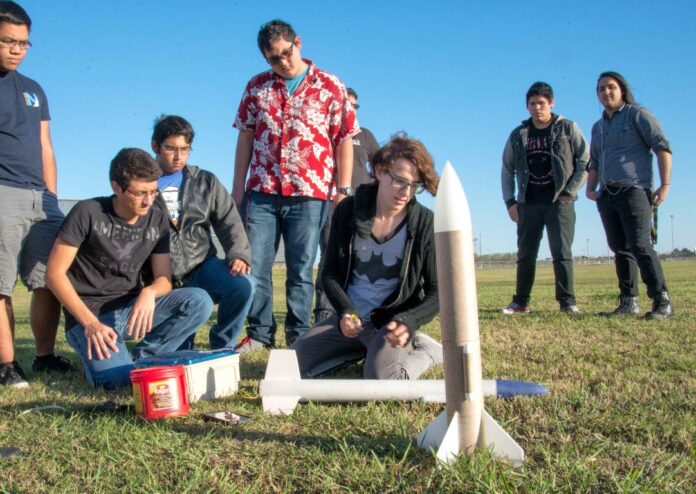HARLINGEN — The rocket screamed into the sky, a sharp, almost burning whisper cutting the air.
The Harlingen High School Engineering and Technology Club had just launched its first rocket of the year, inaugurating its march toward the Team America Rocketry Challenge in May.
“How high?” asked Paul Tenison, club sponsor, as Connor Smith, a senior, returned with the payload.
“Six thirty,” answered Smith, club president, indicating the altimeter read of 630 feet.
“It didn’t go as high as we would have liked,” said Connor, 17. “Today isn’t very good. It’s very windy. We are 220 feet short. This wind pushed it.”
Connor and his fellow club members had met with Tenison behind the Performing Arts Center after school Thursday. They made a test launch with last year’s rocket before sending up this year’s piece.
Some club members approached the launch area with apprehension.
“I’m a little bit nervous,” said Ricardo Flores, 18, a senior. “I didn’t do too much. I put a lot of faith in Connor. He knows what he’s doing. Without him, the rest of us would seem like headless chickens.”
Wires stretched from the motor to an igniter a safe distance away, and were then attached to a battery.
“Test launch — 3, 2, 1,” Connor called out before pressing two red buttons.
Nothing.
“Is it the battery?” asked Tenison, looking everything over. That wasn’t the problem.
“You need to clean these clips,” he said. “Oh, you didn’t have a good connection. Someone needs to clean these clips.”
After some adjustments, Connor went through the countdown again, sending the rocket screeching into the air. After leaving a thin trail of white smoke, the fuselage fell across the street, and the payload crashed without its parachutes opening.
They had an idea of how well the new rocket would perform in the wind, which Tenison estimated at about 20 mph.
Aaron Coronado, 16, joined the club this year. He was fascinated as he watched the other club members prepare the new rocket for launch.
“It’s an amazing experience,” said the sophomore. “I have always been in engineering. This program is different. I didn’t start out with rockets. I have learned quite a bit.”
Connor stuffed flame retardant material soaked with Borax into the fuselage. He waited impatiently for the altimeter from the first rocket to finish resetting. Once it stopped beeping, he was able to attach it to the rocket and everything was set up for the launch.
“Who wants to push the buttons?” he asked. “Make sure these wires are in there tight. Check your air space. Make sure there’s no airplanes overhead.”
Once again he ordered the countdown. The rocket zipped up the launch rail, quickly reaching its peak before two bright red parachutes unfolded to the delight of those below. The rocket’s payload and fuselage were connected, so the students rushed onto the field to retrieve it.
This was one of many test launches they’ll conduct during the next few weeks as they try to adjust the rocket’s weight so it will reach 850 feet in 44.46 seconds.
A member of the National Association of Rocketry will evaluate their qualifying launch March 6. Considering the number of variables involved in a rocket’s speed and altitude, such as the speed and direction of the wind, achieving the right weight for a rocket isn’t an easy task.
“We just make our best guess,” Tenison said.




